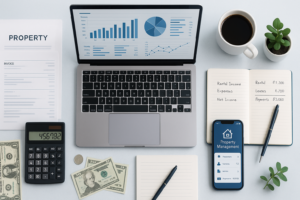
Mastering Rent Roll Analysis: A Guide for Property Managers
If you oversee properties or run a property management firm, the secret to thriving is maximizing rental earnings and streamlining property management for ultimate success. And if you’re curious about this, there’s something powerful to understand that could change the game for you: rent roll analysis.
In this discussion, we’ll delve into what rent roll analysis involves, the perks it brings, and how to automate the process for efficiency. Plus, we’ll share some handy tips for conducting top-notch rent roll research to keep you at the forefront of the property management game. Let’s dive in!
Understanding Rent Roll Analysis
Rent roll analysis is a crucial tool utilized by property managers and rental property investors to assess rent payments, tenant turnover rates, and occupancy rates. It also provides insights into a real estate investment’s current and potential gross rental income.
With comprehensive insight into all aspects related to leasing, including tenancy data and lease contracts, this effective technique aids in optimizing returns from rentals for commercial real estate entities, thereby increasing profits.
A thorough rent roll analysis can provide valuable insights that enhance cash flow and overall profitability in property performance evaluation. This approach also maximizes revenue generated through rents, resulting in higher income streams for residential and commercial property investors.
Think of it as your GPS for navigating the rental landscape. It doesn’t just guide you; it helps you discover untapped revenue streams, especially if you’re juggling multiple properties, whether cozy homes or bustling commercial spaces. It’s your ticket to unlocking the full earning potential in the real estate realm.
Components of Rent Roll Analysis
Rental property owners and managers rely on a comprehensive rent roll analysis to better understand their portfolios. This analysis encompasses crucial details, such as specific house or unit data, comprehensive tenant information, including lease agreements of current tenants, and the precise amount of rent owed by each tenant.
Moreover, a rent roll analysis proves invaluable in identifying issues related to high turnover rates, enabling owners and managers to devise effective strategies to mitigate such challenges. By meticulously analyzing this wealth of information, property managers can devise comprehensive plans to maximize rental revenue while ensuring stringent compliance with legal requirements.
The rent roll analysis is a reliable tool for accurately tracking rental payments and ensuring that no crucial details slip through the cracks. Its meticulous approach helps property owners and managers stay informed and maintain a well-optimized rental business.
The Role of Rent Roll Analysis in Property Management
Rent roll analysis is crucial to property management because it helps managers better grasp the income generated by their rental properties. With a detailed rent roll report, they can dive into tenant data and market rates, which gives them valuable insights to make informed decisions about adjusting rents.
And let’s not forget, these accurate reports are a must-have when applying for loans or considering real estate investments and mortgages. They play a significant role in determining the interest rate and principal amount on loan offers. So, keeping those rent rolls accurate is essential to evaluate performance during these processes.
Benefits of Automating Rent Roll Analysis
Automation has dramatically impacted the real estate business; rent roll analysis is no exception. Automating this type of assessment brings a whole range of benefits for property managers and owners. It helps us stay organized with property management activities, improves the accuracy and consistency of data, and allows us to track and report things instantly.
Plus, rent roll automation saves us money by taking care of tasks like follow-up calls, and it reduces the risks of errors or mistakes that can happen when humans are involved. And here’s the best part: it allows us to make more informed investment decisions because it processes everything so quickly, which was only possible in the past with paper ledger systems.
Tips for Effective Rent Roll Analysis
Thorough Documentation: Make sure your rent roll has all the important details about each tenant, like lease start and end dates, rental rates, and special terms or concessions. Having accurate documentation is crucial for getting valuable insights and analysis.
Regular Updates: Keep the rent roll updated with any changes in tenant information, lease renewals, or modifications. By making timely updates, property managers can stay informed and take proactive actions in response to market dynamics.
Consistency in Format: Keep a standardized format for the rent roll. This will make it easier to compare and analyze trends. Consistent formatting helps with clarity and makes identifying important data points simple.
Segmentation and Categorization: Let’s categorize the rent roll into different sections like residential, commercial, or retail spaces. This way, we can better grasp how the property is performing overall and identify areas where we can potentially make improvements.
Income Analysis: Make sure to regularly check rental income trends and keep an eye out for any unusual patterns. By analyzing income data, property managers can identify units that may not be performing as well and make adjustments accordingly, such as implementing rent increases. This helps optimize overall revenue and ensures the best results for your property.
Elements of the Rent Roll
When analyzing a rent roll, the elements can vary based on the property type and situation. However, most rent roll statements typically include these key elements:
Tenant’s Info: First, you’ve got the tenant’s name. It’s like the ID for who’s renting the place. This keeps things clear and makes it easy for the landlord and tenant to chat.
Unit ID: Think of this like a tag for the spot the tenant’s in – it could be a unit number, floor, or some other way to tell where they’re at in the property. Handy for keeping things organized.
Lease Dates: When did the lease party start, and when is it calling it quits? This helps keep tabs on how long the lease is running and when it might be time for renewals or finding new tenants.
Rent Amount: The cold, hard cash part – how much the tenant is forking over according to the lease. This is like the heartbeat of the property’s income.
Security Cash: A safety net for the landlord – the amount the tenant drops as a security deposit. It’s like a buffer in case things get messy and the property needs some TLC.
Due Date: The day the rent is due each month. It helps landlords keep their financial ducks in a row and manage those payments.
Lease Deets: The nitty-gritty stuff both parties agree on. Like who’s taking care of Fido, who’s paying for the lights, and who’s fixing what. All those house rules.
Pay History: The story of the tenant’s rent payments – when they paid up and if there were any tardy moments. It’s like a track record of reliability.
Owed Balance: If any rent or charges still hang in the air, it’s all here. Keeps tabs on what still needs to make its way into the landlord’s pocket.
Remember, the whole point of this rent roll thing is to give a bird’s eye view of what’s up with the property – who’s in, what’s coming in, and any loose financial ends. So, keep those records sharp and steady!
Final Words
Mastering rent roll analysis is a game-changer for real estate property managers and owners. Seriously, it’s a game-changer! When you understand tenant info, lease agreements, and rental income trends, you can make precise decisions and manage properties like a boss.
And guess what? Automation takes things to a whole new level. It boosts organizational efficiency, ensures accurate data, and helps you make better decisions. But here’s the thing: you must be meticulous with documentation, updates, and formatting. Stay on top of income trends and market dynamics to optimize your revenue and keep that success strong. The rent roll is like your trusty compass, keeping you informed, organized, and successful. So, embrace rent roll analysis for maximum profits and thrive in property management.
Table of Contents
Stay Updated
Subscribe to get the latest news, industry trends, blog posts, and updates...





